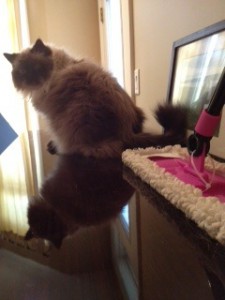
Something that’s in YOUR house could be causing your cat’s hyperthyroidism!

I just read a very interesting new study from the Journal of Toxicology and Environmental Health that looked at a possible cause for hyperthyroidism in cats. The study looked at something called PBDE’s (polybrominated diphenyl ethers) and I can guarantee you that you have these in your house!
 What are PBDE’s?
What are PBDE’s?
PBDE’s are chemicals that are used as a flame retardant. They can be found in many places in our house including our furniture, electronics and building materials. But, more importantly, there are a lot of flame retardant PBDE chemicals in….DUST!
What’s the connection between Flame Retardants and hyperthyroidism?
Years ago it used to be very uncommon for a cat to be diagnosed with hyperthryoidism. It was around 30 years ago that veterinarians started to see an increase in the number of cats they were diagnosing with hyperthyroidism. Coincidentally, it was about 30 years ago that we started to use PBDE’s as a flame retardant chemical in household items.
We know that PBDE’s have an effect on the thyroid gland, and researchers say that there is a good chance that PBDE’s are a main cause for hyperthyroidism in cats. But why? It was previously thought that high levels of PBDE’s in pet food were the main culprit (see this study). (If anyone can tell me why on earth we have flame retardants in our pet foods, please leave me a comment below!) The PBDE’s are thought to accumulate in the thyroid gland and make it more likely to develop a thyroid tumor.
But why dust?
The latest study shows that cat food has a PBDE level of between 0.42 to 3.1 ng/g. As this level is 20-100 times higher than the level of PBDE’s in foods meant for human consumption, it was perviously believed that pet food must be the culprit. However, the 2012 study found out the following interesting facts that lead the researchers to conclude that dust is even more of a contributor to hyperthyroidism than food:
- While cat foods contain 0.42 to 3.1 ng/g of PBDE’s, dust contains 510-95,000 ng/g!
- They measured dust samples in the homes of cats who did not have hyperthyroidism and found levels of PBDE’s between 510 to 4900 ng/g. However, the dust samples in the homes of cats who did have hyperthyroidism had PBDE’s that ranged from 1100 to 95,000 ng/g.
- The amount of PBDE measured in the dust samples correlated highly with how high the cat’s thyroid levels were. (i.e. if the researchers found high levels of flame retardant PBDEs in the dust sample, the cat was much more likely to have a very high thyroid level.)
So, what can be done?
If I had a cat with hyperthyroidism, I would take this as a great excuse to hire a housecleaner! If flame retardants in dust particles are accumulating in your cat’s thyroid gland, who knows how they are affecting the people in your house as well! Another option for helping your cat would be to allow a greater amount of outdoor time. (The study found that cats who were primarily outdoors had much lower levels of PBDE’s in their blood.) And, it is apparently possible to buy furniture and other products that have not had any flame retardants used on them as well.
Related: Now there is a new food to treat hyperthyroidism in cats.
About the author

Dr. Marie is a veterinarian treating dogs, cats, and pocket pets. Click here to ask Dr. Marie a question.




Hmm? A light bulb just came on above my head. Could this also be true for dogs? My Vet recently put one of my dogs on thyroid medicine. Having 5 shedding dogs, sometimes the hair & dust takes over if I don’t clean regularly. Could the dust and hair be the cause of my dog’s thyroid problems?
Hmmm…I haven’t seen anyone make a connection to thyroid issues in dogs yet. Dogs get hypothyroidism (low thyroid) as opposed to hyperthyroidism (high thyroid) so it likely is a totally different issue.